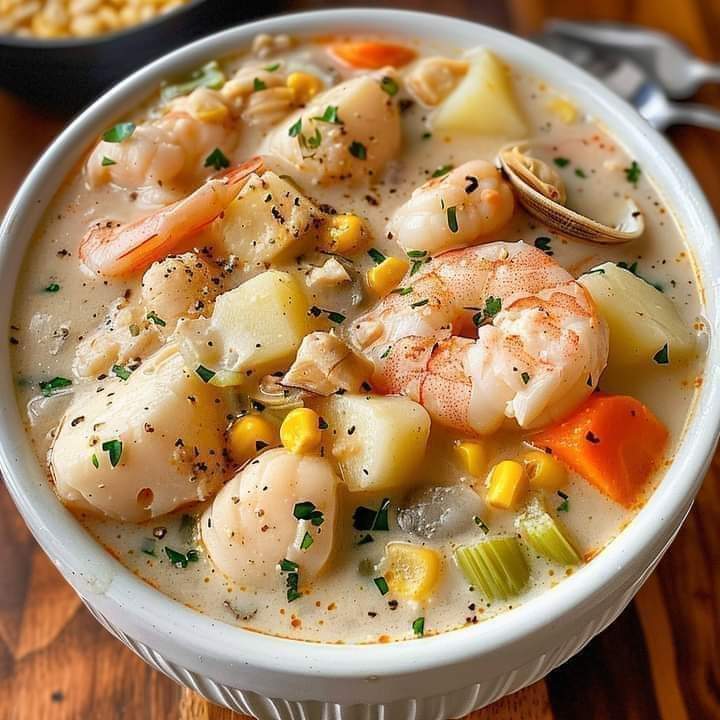Seafood chowder is a hearty and flavorful dish that combines the fresh taste of the ocean with creamy, savory ingredients. It’s the perfect comfort food for chilly days, offering a rich and satisfying bowl packed with various seafood, potatoes, and vegetables. The dish is versatile, allowing for personal variations that can cater to different tastes and preferences.
Origin and Cultural Significance
Chowder has roots in the coastal regions of North America and Europe, with strong historical ties to New England in the United States. Originally made by fishermen using leftover seafood, it was a simple, rustic dish that has since evolved into a beloved staple in coastal cuisine. The word “chowder” likely comes from the French word “chaudière,” referring to the pot in which the stew was cooked. Over time, chowder has become a symbol of maritime culture and is often enjoyed at seafood festivals and family gatherings.
Ingredients
Quantity (Serves 6-8)
1 lb (450g) mixed seafood (shrimp, clams, fish, and scallops)
1 large onion, diced
2 garlic cloves, minced
2 medium carrots, diced
2 celery stalks, diced
3 medium potatoes, peeled and cubed
1 cup (240ml) heavy cream
4 cups (1 liter) seafood or vegetable broth
2 tbsp butter
2 tbsp all-purpose flour (optional, for thickening)
1 bay leaf
1 tsp fresh thyme (or ½ tsp dried)
Salt and pepper to taste
1 tbsp chopped fresh parsley (for garnish)
Optional Additions
1 cup corn kernels (adds sweetness and texture)
1 cup cooked bacon bits (for a smoky flavor)
A splash of white wine (adds depth to the flavor)
A pinch of cayenne pepper (for a hint of heat)
Tips for Success
Use Fresh Seafood: If possible, use fresh, local seafood for the best flavor. Frozen works in a pinch, but fresh seafood will elevate the dish.
Cut Ingredients Evenly: Ensure vegetables are cut into uniform sizes for even cooking.
Simmer Slowly: Don’t rush the cooking process. Slow simmering allows the flavors to meld together beautifully.
Add Dairy at the End: To prevent curdling, always add the cream towards the end of cooking.
Customize the Seafood: Use any seafood you like, from lobster and crab to cod and mussels.
Instructions
Prepare the Base: In a large pot, melt the butter over medium heat. Add the diced onions, carrots, celery, and garlic. Sauté until the vegetables are softened, about 5-7 minutes.
Add Flour (Optional): Stir in the flour to create a roux, cooking for 1-2 minutes. This step is optional if you prefer a thicker chowder.
Cook the Potatoes: Add the potatoes, bay leaf, and thyme, then pour in the seafood or vegetable broth. Bring to a boil, reduce heat, and let it simmer for about 10-15 minutes, or until the potatoes are tender.
Add Seafood: Gently stir in the seafood. Simmer for 5-7 minutes, or until the seafood is just cooked through. Do not overcook, as seafood becomes tough when overdone.
Add Cream: Slowly stir in the heavy cream and let the chowder heat through, but don’t let it boil.
Season and Garnish: Taste and season with salt, pepper, and additional thyme if desired. Garnish with fresh parsley.
Serve: Ladle the seafood chowder into bowls and serve with crusty bread or crackers.
Description
This seafood chowder has a velvety texture, punctuated by the briny sweetness of the seafood and the earthy undertones of potatoes and herbs. The combination of creamy broth, tender seafood, and hearty vegetables makes it a well-balanced and flavorful meal. The optional additions like corn and bacon provide additional layers of flavor and texture.
Nutritional Information (Per Serving)
Calories: 350-400 (varies based on seafood and cream used)
Protein: 20-25g
Fat: 18-22g
Carbohydrates: 25-30g
Fiber: 3-4g
Sodium: 500-600mg
Conclusion and Recommendation
Seafood chowder is an indulgent yet nutritious dish, rich in omega-3 fatty acids from the seafood and packed with vitamins and minerals from the vegetables. It’s an excellent choice for seafood lovers looking for a comforting, one-pot meal. The versatility of this recipe makes it ideal for weeknight dinners, special gatherings, or even as a make-ahead dish for easy meal prep.
